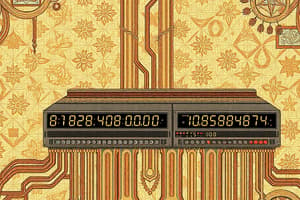Podcast
Questions and Answers
What distinguishes a D type flip flop from a JK flip flop in terms of operation?
What distinguishes a D type flip flop from a JK flip flop in terms of operation?
- D type flip flop captures the input at the edge of the clock signal, while JK can change output anytime. (correct)
- D type flip flop has a toggle action, while JK does not.
- D type flip flop has an additional reset state compared to JK flip flop.
- D type flip flop requires a clock signal, while JK can operate asynchronously.
In the context of registers, which statement most accurately describes a shift register?
In the context of registers, which statement most accurately describes a shift register?
- It uses flip flops to store data and can process data simultaneously.
- It can only convert parallel input to parallel output.
- It always shifts data in one direction either left or right. (correct)
- It requires a larger number of logic gates compared to standard registers.
Which of the following statements is true regarding synchronous down counters?
Which of the following statements is true regarding synchronous down counters?
- They can include multiple flip flops that operate independently.
- They increment the count based on a single external clock signal.
- They operate with a common clock and count down in a synchronized manner. (correct)
- They do not require any reset mechanism for reliable operation.
What is the primary application of a decade counter?
What is the primary application of a decade counter?
Which of the following best describes edge triggering in flip flops?
Which of the following best describes edge triggering in flip flops?
What is a primary advantage of using edge triggering in flip flops?
What is a primary advantage of using edge triggering in flip flops?
Which statement about shift registers is accurate?
Which statement about shift registers is accurate?
How does an asynchronous up counter differ from a synchronous down counter?
How does an asynchronous up counter differ from a synchronous down counter?
What is a common application of a decade counter?
What is a common application of a decade counter?
Which characteristic makes serial to parallel converters important in digital circuits?
Which characteristic makes serial to parallel converters important in digital circuits?
Study Notes
Flip Flops
- SR (Set-Reset) flip flops have two inputs that control the state of the output; they can set, reset, or maintain the output state.
- JK flip flops improve upon SR by having a toggle function, allowing for more versatile memory storage.
- D type flip flops capture the value on the data input (D) at a specific time, usually on the edge of a clock signal.
- Edge triggering refers to the action that occurs at the rising or falling edge of the clock signal, ensuring synchronized operation and reducing glitches.
- Flip flops are used in digital circuits for data storage, registers, counters, and memory devices.
Registers
- Shift registers can shift data in or out, either serially or parallelly, facilitating data manipulation.
- A serial to parallel converter transforms incoming serial data into a parallel format for easier processing and access.
- A parallel to serial converter takes multiple data bits and transmits them sequentially, enhancing communication efficiency.
Counters
- Asynchronous up counters increment the value with each clock pulse without a common clock signal, leading to potential timing issues due to propagation delay.
- Synchronous down counters decrement the value simultaneously on each clock pulse, providing consistent timing across all bits.
- Decade counters count from 0 to 9 and then reset to 0, often used in digital clocks and frequency dividers.
Flip Flops
- SR (Set-Reset) flip flops have two inputs that control the state of the output; they can set, reset, or maintain the output state.
- JK flip flops improve upon SR by having a toggle function, allowing for more versatile memory storage.
- D type flip flops capture the value on the data input (D) at a specific time, usually on the edge of a clock signal.
- Edge triggering refers to the action that occurs at the rising or falling edge of the clock signal, ensuring synchronized operation and reducing glitches.
- Flip flops are used in digital circuits for data storage, registers, counters, and memory devices.
Registers
- Shift registers can shift data in or out, either serially or parallelly, facilitating data manipulation.
- A serial to parallel converter transforms incoming serial data into a parallel format for easier processing and access.
- A parallel to serial converter takes multiple data bits and transmits them sequentially, enhancing communication efficiency.
Counters
- Asynchronous up counters increment the value with each clock pulse without a common clock signal, leading to potential timing issues due to propagation delay.
- Synchronous down counters decrement the value simultaneously on each clock pulse, providing consistent timing across all bits.
- Decade counters count from 0 to 9 and then reset to 0, often used in digital clocks and frequency dividers.
Studying That Suits You
Use AI to generate personalized quizzes and flashcards to suit your learning preferences.
Description
Explore the fundamental concepts of flip flops including SR, JK, and D types, along with edge triggering. This quiz also covers shift registers and converters, as well as various types of counters like asynchronous up counters and synchronous down counters. Test your knowledge on these essential digital electronics components and their applications.




